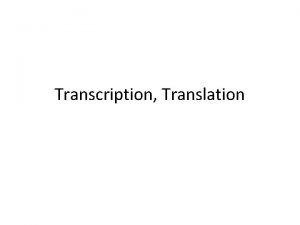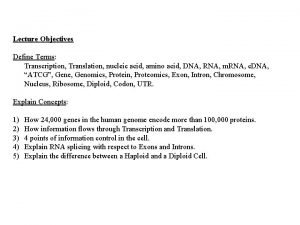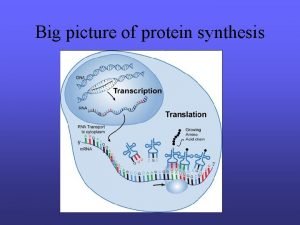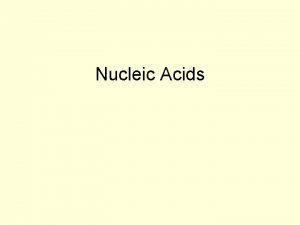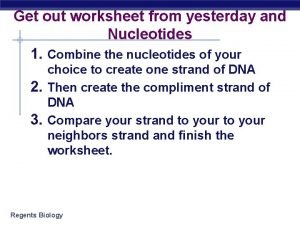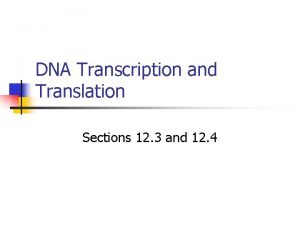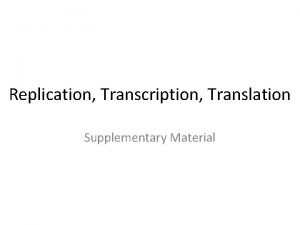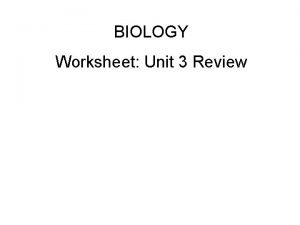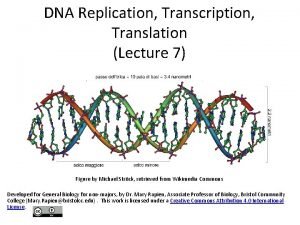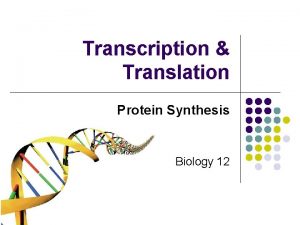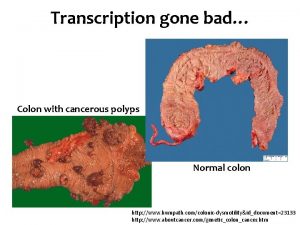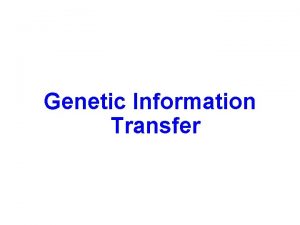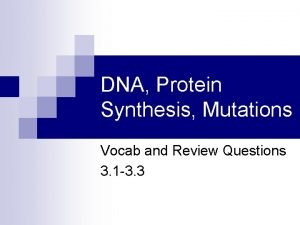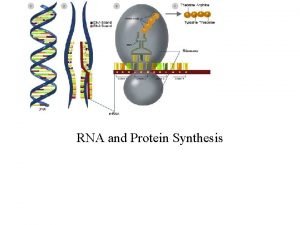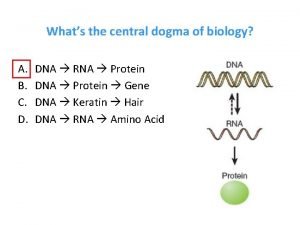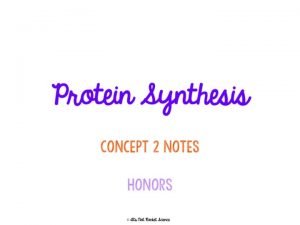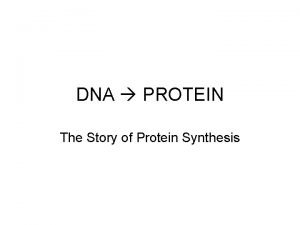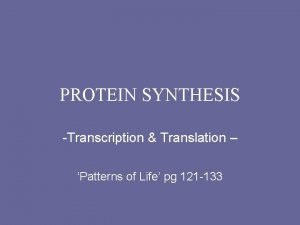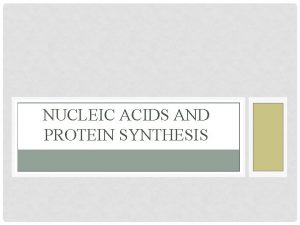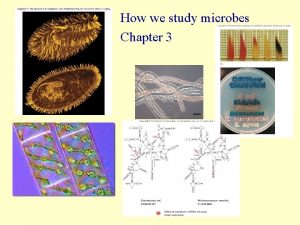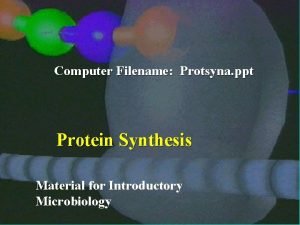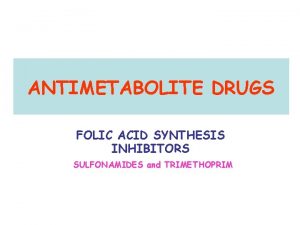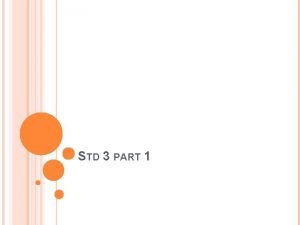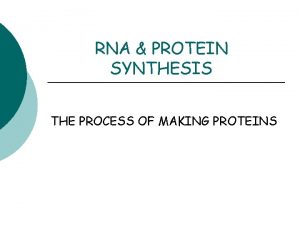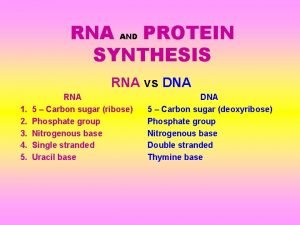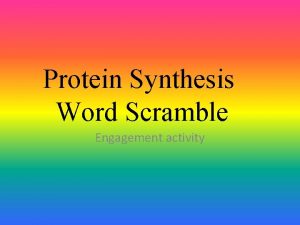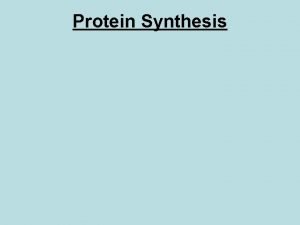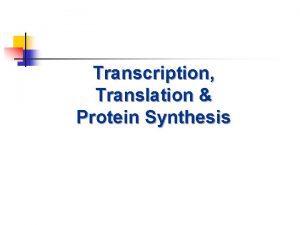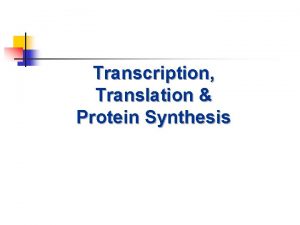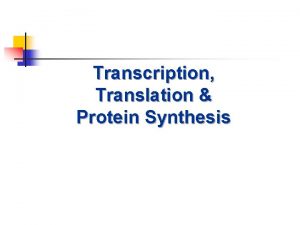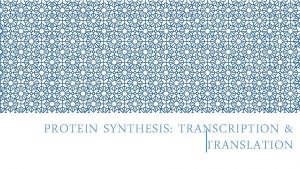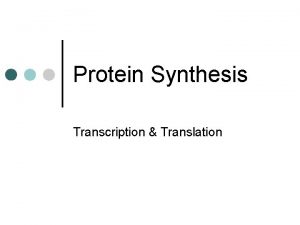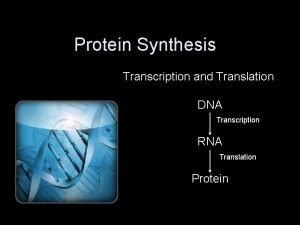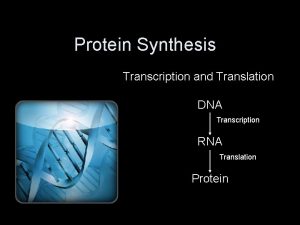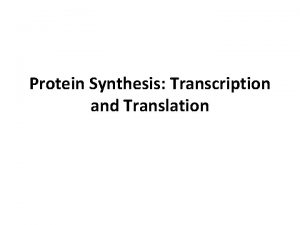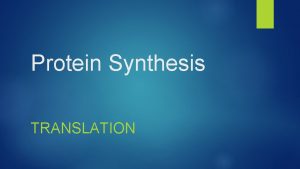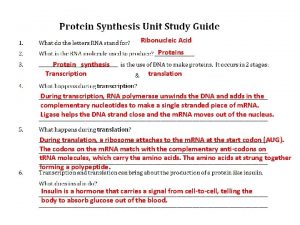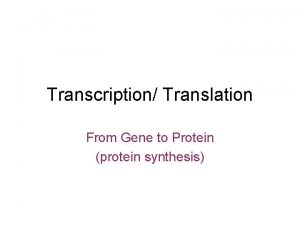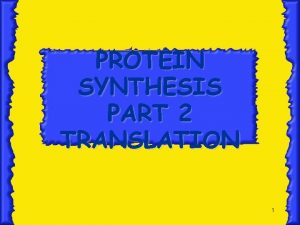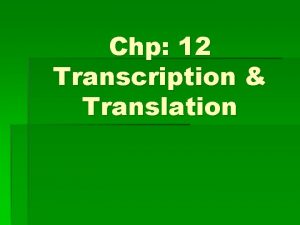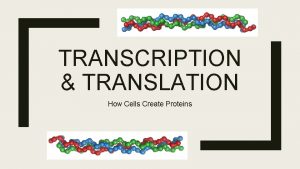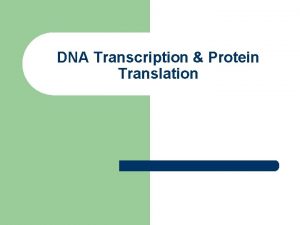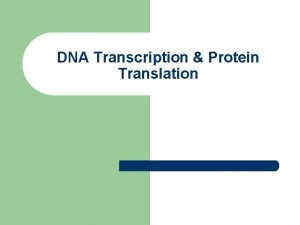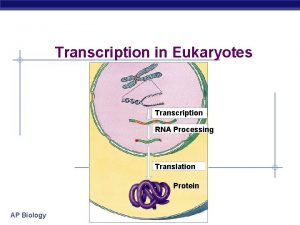Proteins Synthesis Transcription and Translation Protein Synthesis An
















































- Slides: 48

Proteins Synthesis Transcription and Translation

Protein Synthesis: An Overview • Genetic information is contained within the nucleus of a cell • DNA in the nucleus directs protein synthesis but protein synthesis occurs in ribosomes located in the cytoplasm • How does a ribosome synthesize the protein required if it does not have access to DNA?

THE CENTRAL DOGMA OF PROTEIN SYNTHESIS

Protein Synthesis: An Overview • The answer lies in an intermediate substance known as m. RNA. • Information is copied from DNA into m. RNA, this is transcription • m. RNA leaves the nucleus and enters the cytoplasm of the cell • Ribosomes use the m. RNA as a blueprint to synthesize proteins composed of aa, this is translation.

Protein Synthesis: An Overview


DNA 3 main components: • Deoxyribose sugar • Phosphate group • Nitrogenous bases-adenine, guanine, cytosine and thymine • A forms 2 hydrogen bonds to T, G forms 3 hydrogen bonds to C



DNA vs RNA • • • Deoxyribose sugar Double stranded A pairs with T G pairs with C Resides in nucleus • • • Ribose sugar Single stranded A pairs with U G pairs with C Resides in nucleus and cytoplasm

RNA • There are three types of RNA: • m. RNA is the “blueprint” for construction of a protein • r. RNA is the “construction site” where the proteins are made • t. RNA is the “truck” delivering the proper aa to the site of protein synthesis

Genes and Proteins • Genes are a sequence of nucleotides in DNA that code for a particular protein • Proteins drive cellular processes, determine physical characteristics, and manifest genetic disorders by their absence or presence

Genetic Code • Proteins are composed of 20 different amino acids • A sequence of 3 nucleotides is used to code each amino acid • Each triplet of nucleotides is called a codon • Start codon AUG codes for amino acid methionine • 3 stop codons • There are 64 codons in the genetic code 43=64 • Several different codons can code for the same aa, but no codon ever has more than one amino acid counterpart. • Codons are always written in the form of the RNA transcript from the original DNA molecule.

The Universal Code

Characteristics of the Code • Continuity The genetic code reads as a long series of three-letter codons that have no spaces or punctuation and never overlap. • Redundancy – Several different codons can code for the same amino acid, but no codon ever has more than one amino acid counterpart. • Universality – the genetic code is the same in almost all living organisms, from bacteria to mammals

Transcription: Initiation • RNA polymerase binds to a segment of DNA and opens up the double helix • RNA polymerase recognizes the promoter region which is a sequence of DNA rich in A and T bases (TATA box) found only on one strand of the DNA.

Transcription: Initiation • An RNA polymerase cannot recognize the TATA box and other landmarks of the promoter region on its own. Another protein, a transcription factor that recognizes the TATA box, binds to the DNA before the RNA polymerase can do so.

Transcription: Initiation • For transcription to be initiated, both promoter sequences must be present in their correct locations. The nucleotide sequences in the promoters are slightly different from one another, which means the RNA polymerase will bind in only 1 orientation, thus RNA polymerase can only face 1 way during transcription. This ensures transcription will proceed in only 1 direction.

Transcription: Elongation


Transcription : Elongation • The RNA polymerase uses only one of the strands of DNA as a template for m. RNA synthesis. This is called the template strand or sense strand. The coding strand or anti-sense strand contains the complementary nucleotide sequence to the sense strand. • RNA polymerases can add nucleotides only to the 3’ end of a DNA sequence. Thus, an RNA molecule elongates in the 5’ to 3’ direction. • Consider the following DNA sequence 3’ TACTCGTCTTG 5’

The Coding Strand • RNA polymerase uses the template strand to transcribe. Thus the RNA is complimentary to the template. The non-template strand is exactly identical to the m. RNA, but m. RNA has uracil in place of thymine.

Transcription: Termination • As the RNA polymerase molecule passes, the DNA helix re-forms. Synthesis continues until the end of a gene is reached where RNA polymerase recognizes a terminator sequence.

Transcription • Once the RNA polymerase leaves the promoter region, a new RNA polymerase can bind there to begin a new m. RNA transcript. • Since prokaryotes lack a membrane bound nucleus, translation can begin even before the m. RNA dissociates. However the pre-m. RNA from eukaryotic cells needs some modification before it leaves the nucleus.

Processing of m. RNA transcript • In eukaryotes, the m. RNA that is released at the end of transcription is called pre-m. RNA. Prem. RNA undergoes several changes before it is exported out of the nucleus to protect it from the cytoplasmic environment. • The 5’ end of the pre-m. RNA is capped with a modified form of the G nucleotide. At the 3’ end, an enzyme in the nucleus adds the poly A tail, a long series of A nucleotides.

Processing of m. RNA

m. RNA Splicing • The entire gene (introns and exons) are transcribed by the RNA polymerase. • The initial pre-m. RNA contains introns that are removed from the pre-m. RNA by spliceosomes while the exons are spliced together. • INtrons are cut OUT.

m. RNA Splicing • The removal of introns may follow different patterns thus producing different proteins. • This accounts for the fact that the body produces over 100, 000 different proteins even though the human genome only contains about a third number of genes

Alternative Splicing

Alternative Splicing

Translation • After transcription m. RNA exits the nucleus via nuclear pores and ribosomes bind to m. RNA • Ribosomes synthesize different proteins by reading the coding sequence on m. RNA • The m. RNA is read in triplets of nucleotides each of which encodes an amino acid • Consider the following m. RNA sequence: 5’ AUGAGCUGAAC 3’


Transfer RNA • The ribosome alone cannot synthesize the polypeptide chain • The correct amino acids must be delivered to the polypeptide building site by t. RNA

Transfer RNA • t. RNA look like threelobed “cloverleaf” due to base pairing between complementary nucleotides on different regions of each t. RNA molecule causing it to fold

Transfer RNA • At the end of one lobe of t. RNA, a sequence of three bases called the anticodon recognizes and is complementary to the codon of the m. RNA. • The anticodon sequence is written in the 3’ to 5’ direction. • At the 3’ end of the strand is an attachment site for the corresponding aa specified by the m. RNA codon.

Wobble in the Genetic Code • Although there are 64 possible codon combinations, the cytoplasm only holds about 35 -45 different t. RNAs. This leaves some anticodons pairing with more than one codon creating a more lenient compliment in the third position. • This is consistent with the redundancy of amino acid codons in the “wobble position hypothesis”


Aminoacyl-t. RNA synthetase • Aa-t. RNA (t. RNA molecule bound to its particular amino acid) has 2 binding sites; one is for a specific amino acid, the other is specific to a particular anticodon • When both are in the enzyme’s active site the enzyme catalyzes a reaction that binds the two.

Ribosomes • Ribosomes are the site of protein synthesis. A ribosome is a complex that contains a cluster of different kinds of proteins and r. RNA which are linear strands of RNA • The ribosome has binding sites for the m. RNA transcript and the aa-t. RNA molecules.

Ribosomes • Each active ribosome has 3 different binding sites for t. RNA molecules: the P (peptide) site, which holds one aa-t. RNA and the growing chain of amino acids; the A (acceptor) site, which holds the t. RNA bringing the next amino acid to be added to the chain; and the E (exit) site, which releases the t. RNA molecules back into the cytoplasm.

• The anticodon of an aa-t. RNA molecule binds to the m. RNA codon exposed in the A site. • Enzymes catalyze the formation of a bond between the last aa on the lengthening polypeptide and the new aa. The polypeptide chain is transferred from the t. RNA in the P site to the t. RNA in the A site. • The ribosome moves down the m. RNA strand, shifting the binding site a distance of 3 nucleotides (1 codon), this is called translocation. A new A site is exposed as the t. RNA that was in the P site is moved to the E site and released.



Termination of Protein Synthesis • Translocation of the ribosome exposes a stop codon in the A site. Stop codons do not code for an amino acid, there are no corresponding t. RNAs. • A protein called a release factor binds to the exposed A site causing the polypeptide to separate from the remaining t. RNA molecule • Ribosome falls off the m. RNA and translation stops

Termination of Protein Synthesis

Hyperlinks • • Beadle and Tatum Transcription in Prokaryotes vs Eukaryotes Spliceosomes translation narrated Translation Mc. Graw Hill Transcription 2

HOMEWORK 1. Why do all cells need to perform protein synthesis? 2. Why is it important that DNA never leaves the nucleus? 3. Differentiate between the terms transcription and translation. What is the end result of each of these processes and where in the cell do they take place? 4. What amino acids are coded for by each of the following codons? i) UUC ii) ACU iii)GCG iv) UAA 5. Each codon codes for how many amino acids? 6. What codons could code for the amino acid proline (pro) ? For the amino acid arginine (arg)?

7. What are the advantages of having 4 different codons for the amino acid proline? 8. A portion of an m. RNA molecule has the sequence CCUAGGCUA. What is the sequence of the complementary strand of DNA? 9. The following m. RNA strand is being used to assemble a polypeptide strand by a ribosome: • 5’ -AUGCUCAUCGGGGUUUUAAA-3’ a) Write out the amino acids that will be assembled, in their correct order. b) Provide an alternative m. RNA sequence with four or more changes that would translate to the same amino acid sequence.
 Translation protein synthesis
Translation protein synthesis Dna coloring transcription and translation
Dna coloring transcription and translation Perbedaan replikasi virus dna dan rna
Perbedaan replikasi virus dna dan rna Acids and bases venn diagram
Acids and bases venn diagram Protein synthesis bbc bitesize
Protein synthesis bbc bitesize Dna transcription and translation
Dna transcription and translation Dna replication transcription and translation
Dna replication transcription and translation Transcription and translation picture
Transcription and translation picture Translation or transcription
Translation or transcription Biology transcription and translation
Biology transcription and translation Transcription and translation practice worksheet answer key
Transcription and translation practice worksheet answer key Differences between dna and rna
Differences between dna and rna Messenger rna sequence
Messenger rna sequence Transcription translation replication
Transcription translation replication Blood type chart
Blood type chart Replication transcription translation
Replication transcription translation Translation transcription
Translation transcription Transcription or translation
Transcription or translation Translation transcription
Translation transcription Replication
Replication Section 12-3 rna and protein synthesis answer key
Section 12-3 rna and protein synthesis answer key Protein synthesis and mutations
Protein synthesis and mutations Protein synthesis and mutations
Protein synthesis and mutations Protein synthesis and mutations
Protein synthesis and mutations Dna rna and protein synthesis study guide
Dna rna and protein synthesis study guide Rna transfer
Rna transfer Carrier vs channel proteins
Carrier vs channel proteins Protein-protein docking
Protein-protein docking Rna protein synthesis
Rna protein synthesis Order of bases in dna
Order of bases in dna Protein synthesis restaurant analogy
Protein synthesis restaurant analogy Protein synthesis cookie analogy
Protein synthesis cookie analogy Whats the central dogma of biology
Whats the central dogma of biology Transfer rna
Transfer rna Protein synthesis
Protein synthesis Protein synthesis
Protein synthesis Synthesis
Synthesis Protein synthesis animation mcgraw hill
Protein synthesis animation mcgraw hill Test cross definition
Test cross definition Ribonucleic acid
Ribonucleic acid Ribosome
Ribosome Protein synthesis ppt
Protein synthesis ppt Paba
Paba Which best summarizes the process of protein synthesis?
Which best summarizes the process of protein synthesis? Concept map of protein synthesis
Concept map of protein synthesis Protein synthesis
Protein synthesis Protein synthesis scramble
Protein synthesis scramble Protein synthesis steps
Protein synthesis steps What is nucleic acid made of
What is nucleic acid made of

